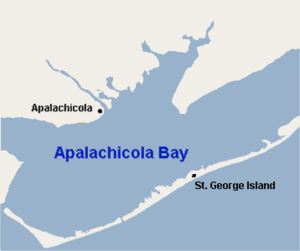Apalachicola Bay facts for kids
Apalachicola Bay is a special water area found on the northwest coast of Florida. It's an estuary, which means it's a place where fresh water from rivers mixes with salty ocean water. It's also a lagoon, a shallow body of water that is partly separated from the sea.
The Apalachicola Bay system includes other water areas like St. George Sound, St. Vincent Sound, and East Bay. Together, they cover a huge area of about 540 square kilometers (208 square miles). Four islands act like natural barriers, separating the bay system from the Gulf of Mexico. These islands are St. Vincent Island, Cape St. George Island, St. George Island, and Dog Island. Water flows in and out of the bay through several channels, like Indian Pass and West Pass.
The Apalachicola River is the biggest source of fresh water for this bay. This river, along with the Chattahoochee River, Flint River, and Ochlockonee River, drains a massive area of over 52,000 square kilometers (20,000 square miles). In 2002, the United States Geological Survey reported that these rivers brought about 555 cubic meters (19,599 cubic feet) of water into the bay every second! This constant flow of fresh water is very important for the bay's health.
The Apalachicola Bay area is a very diverse place. It is home to 1,162 different kinds of plants, including the world's largest natural group of tupelo trees. It also has 308 types of birds, 186 kinds of fish, and 57 types of mammals. In fact, the Apalachicola Reserve stated in 2002 that this area has more different kinds of amphibians and reptiles than any other place in North America, north of Mexico.
Contents
Amazing Animals and Plants
The Apalachicola Bay is famous for its incredible wildlife. It's a vital home for many species, especially oysters.
Oysters and Their Home
For a long time, Apalachicola Bay produced 90 percent of all the oysters in Florida. Oysters need a special mix of fresh and salty water to grow well. This mix is called "brackish" water.
However, the number of oysters in the bay has been going down quickly. This is happening because the amount of fresh water flowing into the bay has changed. When less fresh water enters the bay, the water becomes saltier. This extra saltiness is not good for the oysters. It also means that more animals that eat oysters can live in the bay, which further reduces the oyster population.
A Special Protected Area
Apalachicola Bay is part of The National Estuarine Research Reserve System. This means it's a protected area where scientists study estuaries and work to keep them healthy. This helps protect the bay's unique plants and animals for the future.
Images for kids
See also
 In Spanish: Bahía Apalachicola para niños
In Spanish: Bahía Apalachicola para niños





